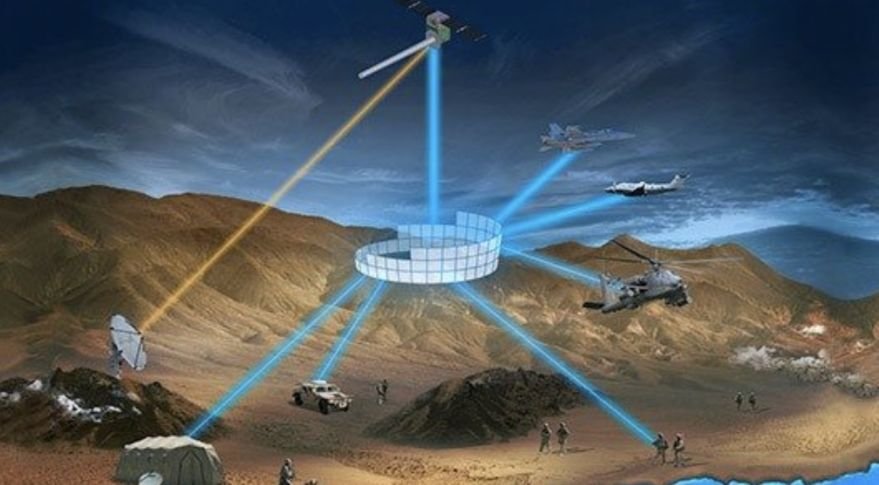
Rendering of the Link 16 tactical data network. Credit: Viasat
By Theresa Hitchens,
Published by Breakinf Defense, 28 November 2023
“We truly have demonstrated that the vision of JADC2 and the vision of the Joint Fires Network is a reality and we can do it,” SDA Director Derek Tournear told Breaking Defense.
Derek Tournear, director of the Space Development Agency director (Air Force photo by Airman 1st Class Raisa Christie)
WASHINGTON — The Space Development Agency (SDA) today announced it has successfully used Link 16 signals to connect its Low Earth Orbit (LEO) satellites to ground-based radios. The first-of-its-kind experiment helps prove the feasibility of using communications satellites to link sensors and shooters across land, sea, air, and space into the Pentagon’s Joint All Domain Command and Control (JADC2) network, according to SDA Director Derek Tournear. What’s more, the connection worked without a new, expensive, bespoke digital data link, instead finding a new use for the venerable Link 16 widely employed by both US and allied forces.
“It’s a big deal,” Tournear told Breaking Defense.
He explained that radios equipped with Link 16 are only radios that can operate across all five US military services as well as allied nations. And up to now, those radios have had a line-of-sight range of some 200 to 300 nautical miles. Basing Link 16 in space effectively allows beyond-line-of-sight communications around the globe in near-real-time.
“We truly have demonstrated that the vision of JADC2 and the vision of the Joint Fires Network is a reality and we can do it,” he said.
The Joint Fires Network is being developed by US Indo-Pacific Command (INDOPACOM) to allow commanders to share data, create a “common operating picture” where all users can see the same up-to-date intelligence, and automate fire control as a first substantiation of JADC2. INDOPACOM expects delivery of an initial prototype next month, and hopes to begin experiments next summer with an operational prototype, according to Signal magazine.
The demos, which took place Nov. 21-27, used three satellites developed by York Space Systems as part of SDA’s first group of experimental birds for its Transport Layer of data relay satellites, called Tranche 0. The agency has ambitious plans to put some 400 Transport Layer satellites up by the end of 2028, developing and launching new variants every two years.
The Link 16 equipped satellites were able to broadcast messages to ground-based radios, provided by the Air Force’s 46th Test Squadron, deployed inside the territory of one of the US’s Five Eyes allies, Tournear said.
SDA, however, has not revealed which of those allies — Australia, Canada, New Zealand and the United Kingdom — is involved due to a request not to do so. But since Tournear mentioned the keen interest of INDOPACOM head Gen. John Aquilino in the Joint Fires Network, that strongly suggests that the ally in question is either Australia or New Zealand.
The reason for doing the testing overseas, rather than in the US, is that SDA remains caught up in a wider Defense Department spat with the Federal Aviation Administration, that is preventing Link 16 use over US territory. Link 16 uses the 960 – 1,215 MHz frequency band, as do civil radio-navigation systems overseen by the FAA, which is responsible for commercial aviation safety.Thus, DoD is required, under a decades-old agreement with FAA, to ensure that all radio equipment using Link 16 has been tested and certified to meet standards against frequency interference. Both FAA and DoD sources say the Pentagon has been lackadaisical about doing so for terrestrially-based radios over the past several year — so SDA’s novel space-based Link 16 terminals are waiting in a long line.
The tests in allied territory will continue until the team from the 96 Test Wing’s 46 Test Squadron comes home for the holidays at the end of December, Tournear said. SDA hopes to start work with other international partners in different regions and begin testing with maritime radios on ships in international waters early next year, he added.
While Link 16 connectivity is line-of-sight, Tournear explained that the next iteration of Transport Layer satellites, called Tranche 1, will include 126 satellites and thus ensure that at least two satellites will be over the horizon 90 percent of the time. Furthermore, he said, most of the antennas used by military Link 16 radios are nearly omnidirectional, so they don’t have to be directly pointed at a signal source to connect.
He noted that the “stressing case” for the satellite’s Link 16 terminals will be connecting to a handheld AN/PRC-161 Link16 Battlefield Awareness and Targeting System – Dismounted (BATS-D) radio, because of all the radios used by military forces, it has the “lowest gain antenna.”
The AN/PRC-161 was designed to provide machine-to-machine linkages between handheld radios being used by troops on the ground and those on aircraft providing close air support. It is expected to be used by US and Five Eyes forces alike. The Air Force in 2019 granted a contract worth up to $93 million to Viasat for production of radios for special operations and expeditionary forces, with work set to be completed by the end of the year.
See: Original Article





